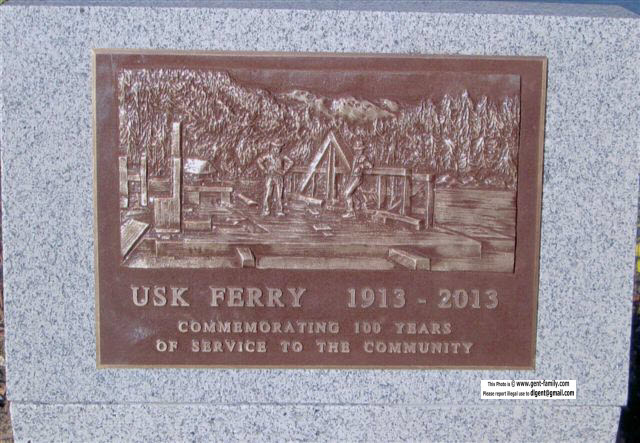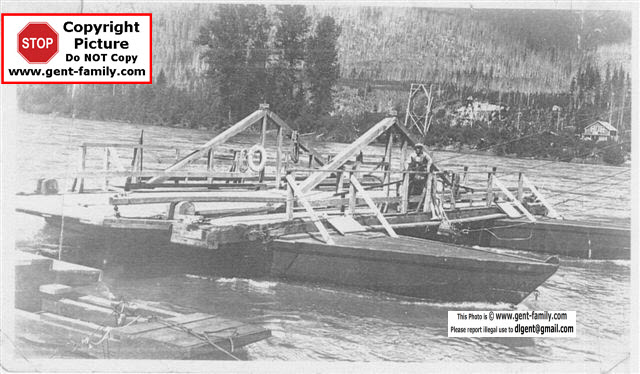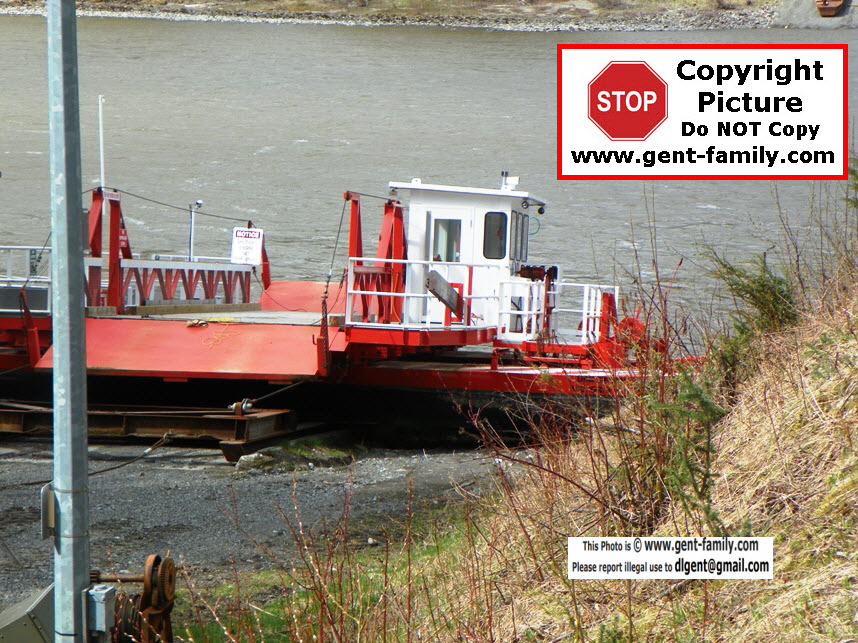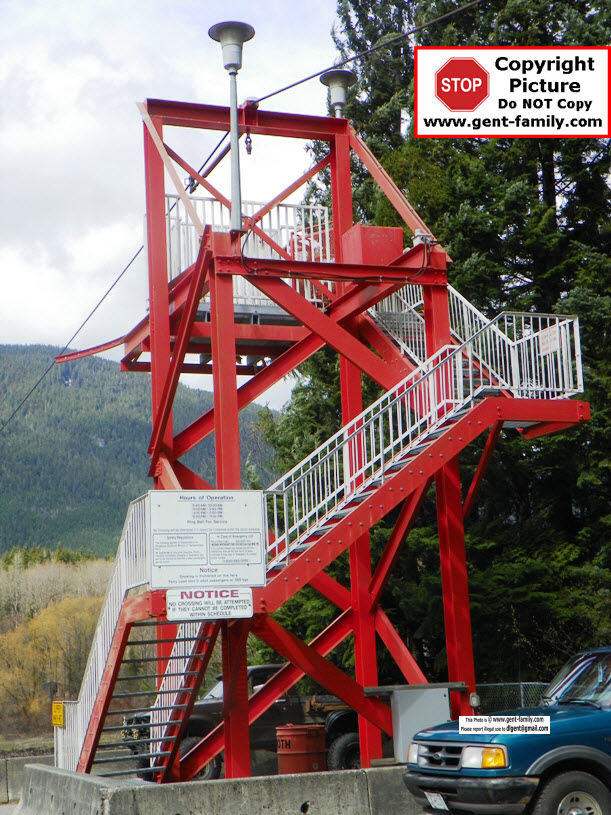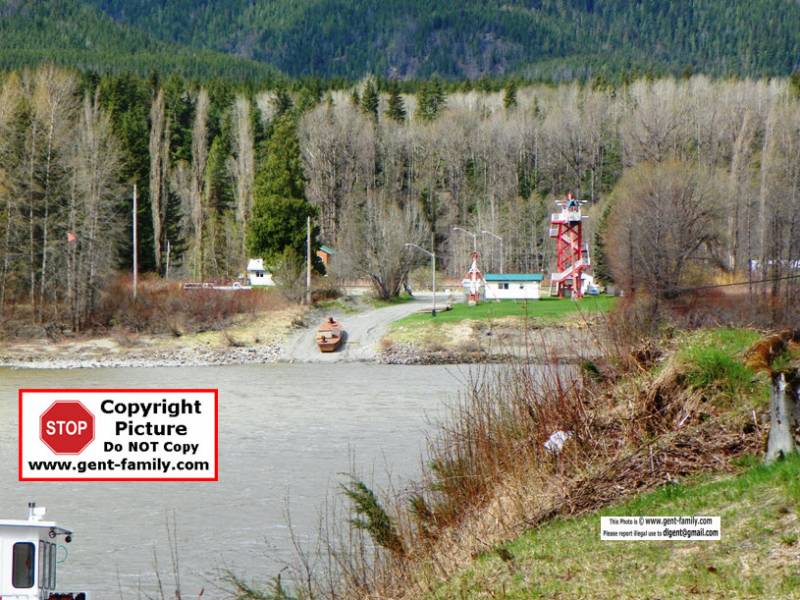Table of Contents

Usk- Reaction Ferry
Usk Ferrymen
Capt. William Francis Madden became Ferryman after Sternwheelers quit running
1917- the ferryman was named Erickson, the cable broke, and the scow went downriver
Mr. Erickson lost 2 fingers in the accident.
Milo Cecil Kendall
- b- Jan 16, 1873 in Toulon, Stark Co., Illinois, USA
- d- ? , bef July 1926, Drowned, but I don't know where, Yet!
- He might have drowned in the Goat River area, Cariboo.
- son of Zelotous (Zelotas?) Kendall, and Nancy Wolf
- Immigrated in 1894
- Naturalized in 1900
- 1901 census shown in Lorne Creek, b- 1850, age 51, occupation- miner
- He enlisted in WWI, Feb 12, 1916, in Prince Rupert, Reg #703723, Army, Canadian Infantry, 102nd Batt.
- living in Kitselas when he enlisted, shown as a miner, married
- married Ida “Elizabeth” Holcomb, Jan 30, 1906, Red Oak Montgomery, Iowa
- b- Feb, 1864, in Scott Co. Iowa, USA
- d-
- daughter of Jededia Loomis Holcomb and Jan McMellen
- 1911 both living at Kitselas Hotel, in Kitselas
- He had Placer leases that his wife sold after he drowned.
- Nov 10, 1906 he was in charge of the Toulon mine at Kitselas and had 7-10 men working all winter on it.
- Shows as Toulon Mine Superintendent in 1914 Mining Report.
- M. C. Kendall was Ferryman at Usk, in 1920
Carl Joseph Halvar Dorum
- but of course in English, Charles J. H. Durham
- b- Aug. 21, 1861 in Molde, Norway
- d- Sept 13, 1958 at Usk, B.C.
- Ferryman ca 1920's.
- 1930 Directory shows him Ferryman
- See the main Usk Page for more info
James William “Jim” Eckert
- b- Apr 1847 (age 74 in 1921 in Usk) in USA
- d- Mar 23, 1940, in Sidney BC, age 95
- Ferryman ca 1923-1925
- Immigrated in 1903
- Both parents born in Germany
- broke his hip in 1923 while working on the ferry
- Nov 1924 he is shown as approaching age 78
- married with grandchildren in Usk, ca 1923
- 1st wife- Lenora Brown
- b- 1855, d- 1928
- they had 4 children
- oldest son- William Anderson Eckert,
- b- 1876, age 34 in 1921 in Usk, born in USA
- d- 1947
- 2nd wife- Orinda “May” E. Eckert, nee Ralston,
- b- 1865, d- 1926, age 5? in 1921, born in USA
- 1916 she is his wife in Red Deer, AB
- She is shown as his wife in 1921 census, in Usk
- They had 3 children
- 3rd wife- Elizabeth Rolston
Frederick Albert “Fred” Stewart
- b- Dec 15, 1892 in Liverpool England
- d- Oct 19, 1934 in Hazelton BC, age 43
- reg # 102944
- enlisted in Victoria BC, Oct 25, 1915
- next of kin Mrs H. C. Bolt, St. Helens CA
- 1921 census shows him as Frederick Alfred Steward
- Ferryman ca 1932
- shown in 1934 and 1935 directories as ferryman, Prospector (Served in WWI)
- Immigrated in 1908
- wife- Dorothy Theresa Stewart, age 30 in 1921 b- ca 1891, in England
- daughter- Dorothy Belinda Stewart, b- ca 1920 in BC
Carle George “Carl” Brechin
- b- Oct 3, 1899 in Berwick County, NS
- d- Sept 26, 1969 in Prince Rupert General Hospital, age 69
- married Mildred Eva Butt, Nov 18, 1929 in Terrace BC
- Carl was Ferryman before Roy Fredrickson
- shown in 1939 and 1941 Directories as Ferryman
- shown as a Power Company lineman when he died
- son of Carleton George Brechin and Cassie Bethwick
Roy F. Fredrickson
- b- June 24, 1887, in Helsingland, Sweden
- d- Dec 10, 1946, on CN Train on route from Usk to Smithers, age 59
- Buried in Kitsumgallum Cemetery, Terrace BC
- Ferryman July 1941- Dec 10, 1946
- shown as ferryman in 1945 Directory
- He was injured helping to push truck out of a snowbank, and died from his injuries.
- married to Dorothy Stewart
- On husband's death, She was paid $255, 3 months salary in 1946.
Benjamin Felix Seymour
- b- Sept 2, 1892, in Port Essington, BC
- d- Jan 28, 1968 Mills Memorial Hospital, Terrace BC, age 75
- buried in Kitsumgallum Cemetery, Terrace
- Native from Kitselas
- married to Madoline Seymour, nee ?, when he died
- son of David Seymour, and Rebecca
George Edward Wright
- b- Nov 1, 1905, Kitsalas Village, BC
- d- Dec 11, 1981 Mills Memorial Hospital, Terrace BC
- buried in Terrace Municipal Cemetery, Terrace BC
- widower when he died
- Native from Kitselas
- George later took over the Copper River Ferry
- son of Walter Wright and Emma
- married to Louise Annie Wesley
George Lester Kellogg
- b- Mar 20, 1910 North Battleford, SK
- d- Nov 13, 1975, Mills Memorial Hospital, Terrace BC, age 65
- father- Chester Kellogg,
- b- 1878, USA
- Rancher in Porkdale, North Battleford, SK in 1921
- mother- Usena Abiggle “Maggie” Kellogg, nee Walker,
- b- 1878 in ON
- Kellogg family Immigrated in 1903 to Canada
- George's wife- Myrta Steeg
- George's siblings:
- Melvin Kellogg, b- 1902 in US
- Grace Emily Kellogg, b- Feb 14, 1906 in North Battleford, SK
- James Chester Kellogg, b- Dec 14, 1908 in North Battleford, SK
- Lawrence Kellogg, b- 1912 in SK
- Usena “Alice” Kellogg, ca 1913 in SK
- Allan Kellogg, ca 1916 in SK
- Ether Kellogg, b- ca 1917 in SK
- Edgar Kellogg, b- ca 1921 in SK
- 1916 family in North Battleford, SK
Gunnar Waldeck
- b- Apr 23, 1904 in Sweden
- d- Oct 9, 1971 Mills Memorial Hospital, Terrace BC, age 67
- buried in Terrace City Cemetery
- Trapper, Part time Ferryman, Single
- son of Halmer Waldeck
Daniel “Dan” Hamilton
- Ferryman for 10 years, Ferryman 2018
If you know of other Ferrymen names please send them in.
Sharon Larose submitted the following names of more Ferrymen, and 1 Ferrywoman, or Ferry Operators?, Aug 1, 2020
Her Great Great Grandparents named Macdonnell, lived in Usk
Willard Seymour
Tim West Johnson
Tom Brophy
Maureen Bostock
Paul Dacey
Below is a history article sent to me by Helene McRae on the Usk Ferrymen
Don’t Forget the Ferrymen at Usk
The Usk ferry recently celebrated a century of service, and while the watercraft was recognized, long-time area residents say it’s the ferryman they will never forget.
Usk (pronounced like “tusk” – without the “t”) sprang up 16 kilometres east of Terrace after the end of the riverboat era and the completion of the Grand Trunk Pacific Railroad in the early 1900s. Forestry, minerals and agricultural land drew people to the remote spot and sawmills were opened to serve mining businesses, and construct a public school, hotel and other buildings. Back then, the Skeena River and the railway were the only form of transportation in Northwest BC, and the Usk Ferry took residents from the hamlet, located on the north side of the river, to the south side to log, prospect or do other activities.
Crossing in Winter
When the river iced up in winter, the ferryman was still responsible for getting people to the other shore, navigating through ice jams that piled up to six metres high on the banks. To get people across, the ferryman marked a trail, laid down planks with scaffolding, or used a small shallow boat, at times transferring travelers from one section of ice to the other using the skiff.
“I don't know how we survived,” recalls early Usk Resident, Helene McRae, nee Adams. “When the ferry was not in operation, either a small boat was used or one would have to walk across the river on the ice. Using the boat, the ferryman had to dodge debris and ice floes, and when we walked on the ice, sometimes there were patches of water with a board across the opening. The operator set up and maintained this system, often during cold, dark and snowing conditions, and many can assure you, with howling winds along the river.”
Helene’s father, DIck Adams, owned a Sawmill on the south side of the river, which ran from the 1940's until 1960, and most of the crew regularly made the crossing for work. One extra cold day, Helene and the crew started home by boat, and the thick ice floes began to back up, from a blockage further downstream in Kitselas Canyon.
“Luckily we were able to turn back or we would have been caught in the moving ice. For three years, I crossed the Skeena for work – lots of scary times.”
Those scary times included when the backed up ice at the Kitselas Canyon unclogged and the ice at Usk might suddenly evacuate downstream. “One day, I was to cross at 2 p.m., and for some reason I was a bit late finishing up at the office. I looked out the window and the whole river had opened up! George Kellogg, The Ferryman, was frantic and was calling across the river to see if I had started across.”
Coming of the Cable Car ??????
NOTE:
Not sure when this was put in operation- D.O.H. put in new towers etc. Shortly after that, an overhead passenger cable car was installed for when the crossing was hazardous due to ice or water levels. Late 60’S, 70’S???????
When Highway 16 was built in the early 1960s on the south side of the swift Skeena, it improved mobility, and people and businesses established themselves there.
Over time, between two major floods and the draw of opportunities elsewhere, the original hamlet of Usk (on the north side of the Skeena River) dwindled to about 30 people. The provincial government has been operating the ferry since the 1920s, and today the Ministry of Transportation and Infrastructure provides the service through a contractor, Nechako Northcoast Construction. The free five-to-seven-minute crossing uses the power of the Skeena River, and an overhead cable suspended by towers, to traverse the waterway. The on-demand ferry operates from 6:15 a.m. to 11:45 p.m. – just ring the bell on the south side and the ferryman will get you across.
Dan Hamilton, an Usk ferryman for 10 years whose father was also a ferryman, says that even in the old days of walking or paddling over the ice-choked river, the ferrymen never lost anyone. “Now you wouldn’t even consider doing something like that, but it was commonplace then,” he says.
“The skill and hard work of those people over the past hundred years deserve a mark of appreciation and recognition,” says Helene. Here’s to all the ferrymen – past and present!
Photos below taken Apr 27, 2014 by my daughter Amber Gent
See my main Usk Page
More Inland Reaction Ferry Pages
and NW BC Logger's Memorial, Usk
Ext Links
Note- not my pages
Gov't Ferry Schedule
http://www.th.gov.bc.ca/marine/ferry_schedules.htm
Ferry Story- Nov 2013
http://tranbc.ca/2013/11/07/saluting-a-century-of-usks-skeena-river-ferrymen/
